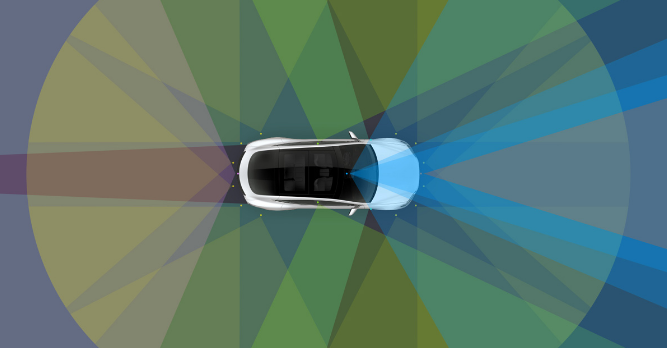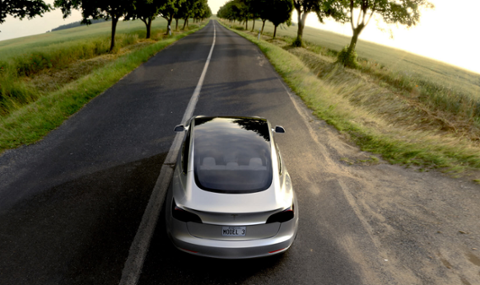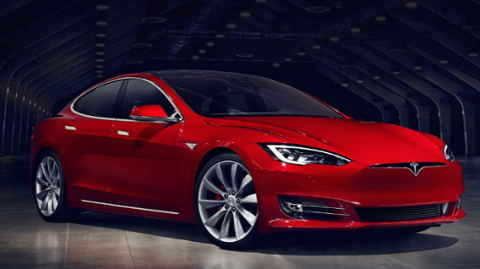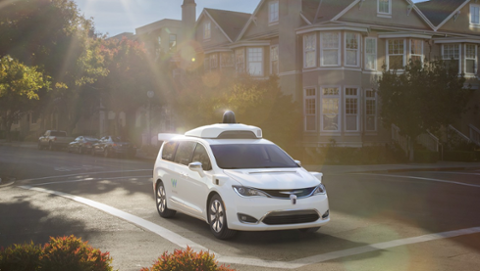 Tesla plans on integrating new hardware into all of its vehicles that will allow “full” self-driving capabilities, according to a corporate blog posting. This hardware will include eight cameras with 360-degree visibility around the vehicle, 12 updated ultrasonic sensors, and forward-facing radar. The cameras can reportedly detect objects at up to 250 meters of range. The data from all those various cameras and sensors will feed to an upgraded onboard computer that runs a “neural net for vision, sonar, and radar processing software.” The net result: a vehicle that can sense in every direction at the same time, in ways that would elude normal human sight. Here, watch it in action, courtesy of Tesla: Tesla plans on integrating new hardware into all of its vehicles that will allow “full” self-driving capabilities, according to a corporate blog posting. This hardware will include eight cameras with 360-degree visibility around the vehicle, 12 updated ultrasonic sensors, and forward-facing radar. The cameras can reportedly detect objects at up to 250 meters of range. The data from all those various cameras and sensors will feed to an upgraded onboard computer that runs a “neural net for vision, sonar, and radar processing software.” The net result: a vehicle that can sense in every direction at the same time, in ways that would elude normal human sight. Here, watch it in action, courtesy of Tesla: But it’s questionable whether this system will roll out in the near term. “Before activating the features enabled by the new hardware, we will further calibrate the system using millions of miles of real-world driving,” the blog posting concluded. “While this is occurring, Teslas with new hardware will temporarily lack certain features currently available on Teslas with first-generation Autopilot hardware.” Tesla has moved aggressively in the self-driving space. In late 2015, as Google and other tech firms continued to cautiously test their autonomous-vehicle software in controlled environments, Tesla CEO Elon Musk decided that the time had come for Tesla vehicles to take over certain functions from human drivers, including highway cruising. “It works almost to the point where you can take your hands off… but we won’t say that. Almost,” Musk told Wired at the time. The next summer, a self-driving Tesla plowed into a truck in Florida, killing the owner. That fatality sparked off considerable debate over whether Tesla was pushing autonomous-driving technology too far, too fast. While Musk has always promised that Tesla vehicles would eventually have a full sensor suite capable of taking over completely from a flesh-and-blood driver, the company found itself under considerable pressure to ensure that autonomous driving is as safe as possible. The result is this week’s announcement—as well as Tesla’s assurance that various self-driving features will only be turned on after additional rounds of testing and verification. With Google, Uber, Apple, and other firms all seeking to commercialize the various aspects of self-driving hardware and software, Tesla has no choice but to try and stay on the forefront of technology. For tech pros interested in the automobile industry, this competition is good news, as it potentially translates into more jobs and interesting projects.
Tesla plans on integrating new hardware into all of its vehicles that will allow “full” self-driving capabilities, according to a corporate blog posting. This hardware will include eight cameras with 360-degree visibility around the vehicle, 12 updated ultrasonic sensors, and forward-facing radar. The cameras can reportedly detect objects at up to 250 meters of range. The data from all those various cameras and sensors will feed to an upgraded onboard computer that runs a “neural net for vision, sonar, and radar processing software.” The net result: a vehicle that can sense in every direction at the same time, in ways that would elude normal human sight. Here, watch it in action, courtesy of Tesla: Tesla plans on integrating new hardware into all of its vehicles that will allow “full” self-driving capabilities, according to a corporate blog posting. This hardware will include eight cameras with 360-degree visibility around the vehicle, 12 updated ultrasonic sensors, and forward-facing radar. The cameras can reportedly detect objects at up to 250 meters of range. The data from all those various cameras and sensors will feed to an upgraded onboard computer that runs a “neural net for vision, sonar, and radar processing software.” The net result: a vehicle that can sense in every direction at the same time, in ways that would elude normal human sight. Here, watch it in action, courtesy of Tesla: But it’s questionable whether this system will roll out in the near term. “Before activating the features enabled by the new hardware, we will further calibrate the system using millions of miles of real-world driving,” the blog posting concluded. “While this is occurring, Teslas with new hardware will temporarily lack certain features currently available on Teslas with first-generation Autopilot hardware.” Tesla has moved aggressively in the self-driving space. In late 2015, as Google and other tech firms continued to cautiously test their autonomous-vehicle software in controlled environments, Tesla CEO Elon Musk decided that the time had come for Tesla vehicles to take over certain functions from human drivers, including highway cruising. “It works almost to the point where you can take your hands off… but we won’t say that. Almost,” Musk told Wired at the time. The next summer, a self-driving Tesla plowed into a truck in Florida, killing the owner. That fatality sparked off considerable debate over whether Tesla was pushing autonomous-driving technology too far, too fast. While Musk has always promised that Tesla vehicles would eventually have a full sensor suite capable of taking over completely from a flesh-and-blood driver, the company found itself under considerable pressure to ensure that autonomous driving is as safe as possible. The result is this week’s announcement—as well as Tesla’s assurance that various self-driving features will only be turned on after additional rounds of testing and verification. With Google, Uber, Apple, and other firms all seeking to commercialize the various aspects of self-driving hardware and software, Tesla has no choice but to try and stay on the forefront of technology. For tech pros interested in the automobile industry, this competition is good news, as it potentially translates into more jobs and interesting projects. Tesla Upgrading Its Self-Driving Tech
 Tesla plans on integrating new hardware into all of its vehicles that will allow “full” self-driving capabilities, according to a corporate blog posting. This hardware will include eight cameras with 360-degree visibility around the vehicle, 12 updated ultrasonic sensors, and forward-facing radar. The cameras can reportedly detect objects at up to 250 meters of range. The data from all those various cameras and sensors will feed to an upgraded onboard computer that runs a “neural net for vision, sonar, and radar processing software.” The net result: a vehicle that can sense in every direction at the same time, in ways that would elude normal human sight. Here, watch it in action, courtesy of Tesla: Tesla plans on integrating new hardware into all of its vehicles that will allow “full” self-driving capabilities, according to a corporate blog posting. This hardware will include eight cameras with 360-degree visibility around the vehicle, 12 updated ultrasonic sensors, and forward-facing radar. The cameras can reportedly detect objects at up to 250 meters of range. The data from all those various cameras and sensors will feed to an upgraded onboard computer that runs a “neural net for vision, sonar, and radar processing software.” The net result: a vehicle that can sense in every direction at the same time, in ways that would elude normal human sight. Here, watch it in action, courtesy of Tesla: But it’s questionable whether this system will roll out in the near term. “Before activating the features enabled by the new hardware, we will further calibrate the system using millions of miles of real-world driving,” the blog posting concluded. “While this is occurring, Teslas with new hardware will temporarily lack certain features currently available on Teslas with first-generation Autopilot hardware.” Tesla has moved aggressively in the self-driving space. In late 2015, as Google and other tech firms continued to cautiously test their autonomous-vehicle software in controlled environments, Tesla CEO Elon Musk decided that the time had come for Tesla vehicles to take over certain functions from human drivers, including highway cruising. “It works almost to the point where you can take your hands off… but we won’t say that. Almost,” Musk told Wired at the time. The next summer, a self-driving Tesla plowed into a truck in Florida, killing the owner. That fatality sparked off considerable debate over whether Tesla was pushing autonomous-driving technology too far, too fast. While Musk has always promised that Tesla vehicles would eventually have a full sensor suite capable of taking over completely from a flesh-and-blood driver, the company found itself under considerable pressure to ensure that autonomous driving is as safe as possible. The result is this week’s announcement—as well as Tesla’s assurance that various self-driving features will only be turned on after additional rounds of testing and verification. With Google, Uber, Apple, and other firms all seeking to commercialize the various aspects of self-driving hardware and software, Tesla has no choice but to try and stay on the forefront of technology. For tech pros interested in the automobile industry, this competition is good news, as it potentially translates into more jobs and interesting projects.
Tesla plans on integrating new hardware into all of its vehicles that will allow “full” self-driving capabilities, according to a corporate blog posting. This hardware will include eight cameras with 360-degree visibility around the vehicle, 12 updated ultrasonic sensors, and forward-facing radar. The cameras can reportedly detect objects at up to 250 meters of range. The data from all those various cameras and sensors will feed to an upgraded onboard computer that runs a “neural net for vision, sonar, and radar processing software.” The net result: a vehicle that can sense in every direction at the same time, in ways that would elude normal human sight. Here, watch it in action, courtesy of Tesla: Tesla plans on integrating new hardware into all of its vehicles that will allow “full” self-driving capabilities, according to a corporate blog posting. This hardware will include eight cameras with 360-degree visibility around the vehicle, 12 updated ultrasonic sensors, and forward-facing radar. The cameras can reportedly detect objects at up to 250 meters of range. The data from all those various cameras and sensors will feed to an upgraded onboard computer that runs a “neural net for vision, sonar, and radar processing software.” The net result: a vehicle that can sense in every direction at the same time, in ways that would elude normal human sight. Here, watch it in action, courtesy of Tesla: But it’s questionable whether this system will roll out in the near term. “Before activating the features enabled by the new hardware, we will further calibrate the system using millions of miles of real-world driving,” the blog posting concluded. “While this is occurring, Teslas with new hardware will temporarily lack certain features currently available on Teslas with first-generation Autopilot hardware.” Tesla has moved aggressively in the self-driving space. In late 2015, as Google and other tech firms continued to cautiously test their autonomous-vehicle software in controlled environments, Tesla CEO Elon Musk decided that the time had come for Tesla vehicles to take over certain functions from human drivers, including highway cruising. “It works almost to the point where you can take your hands off… but we won’t say that. Almost,” Musk told Wired at the time. The next summer, a self-driving Tesla plowed into a truck in Florida, killing the owner. That fatality sparked off considerable debate over whether Tesla was pushing autonomous-driving technology too far, too fast. While Musk has always promised that Tesla vehicles would eventually have a full sensor suite capable of taking over completely from a flesh-and-blood driver, the company found itself under considerable pressure to ensure that autonomous driving is as safe as possible. The result is this week’s announcement—as well as Tesla’s assurance that various self-driving features will only be turned on after additional rounds of testing and verification. With Google, Uber, Apple, and other firms all seeking to commercialize the various aspects of self-driving hardware and software, Tesla has no choice but to try and stay on the forefront of technology. For tech pros interested in the automobile industry, this competition is good news, as it potentially translates into more jobs and interesting projects. 


